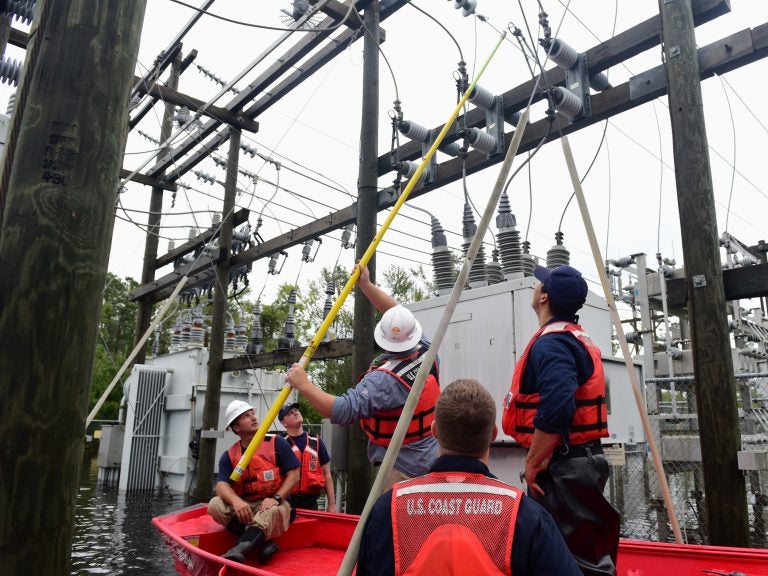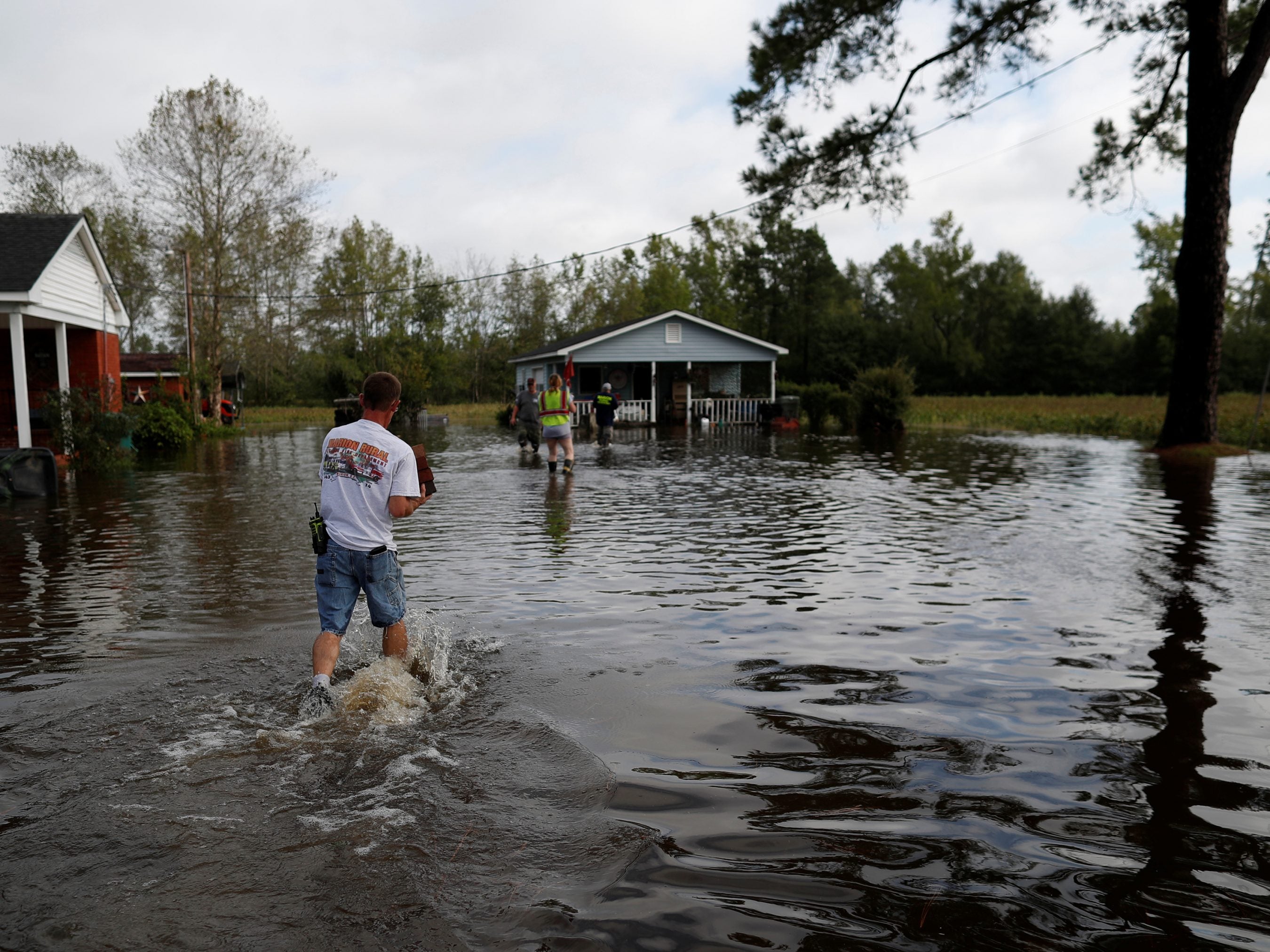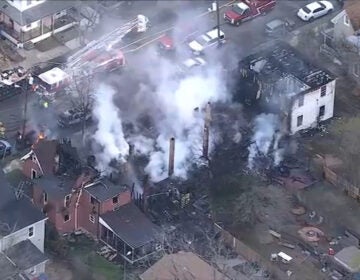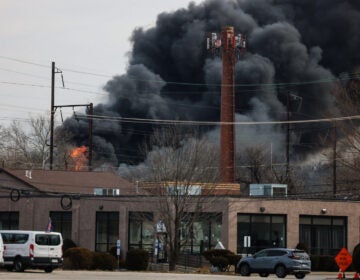Florence death toll rises to 23 as rivers continue to flood in N.C. and S.C.

Members of the Coast Guard Shallow-Water Response team escort utility workers to a flooded substation to inspect transformers in Newport, N.C., on Sunday. (U.S. Airman 1st Class Jacob Derry/Coast Guard / Reuters)
Updated at 12:45 p.m. ET
People in North Carolina and South Carolina are coping with flooding, closed roads and power outages as they assess damage from Hurricane Florence. The storm is blamed for at least 23 deaths, and life-threatening floods are expected to continue all this week, the National Weather Service says.
“As of this morning, North Carolina has 17 confirmed deaths due to this storm,” Gov. Roy Cooper said in an update at noon ET on Monday. An additional six deaths have been reported in South Carolina.
The tragic toll in North Carolina includes a toddler who died in Union County; Kaiden Lee-Welch, 1, was swept away from his mother, whose car had been overcome by floodwaters. The local sheriff’s office said Kaiden’s mother had apparently driven around barricades on Highway 218. A prolonged search and rescue operation led to the recovery of the boy’s body Monday.
Particularly in eastern North Carolina, conditions “remain extremely dangerous,” Cooper said. He added: “Don’t drive around barricades. We’re seeing this happen now, and the result is not good.”
For many towns in the state, “the danger is still immediate,” Cooper said, despite the promise of clearing skies as rainy weather finally starts to leave the state.
Emergency crews have rescued 2,600 people and more than 300 animals, Cooper said. He added that there are currently more than 14,000 evacuees in shelters in his state.
In Pollocksville, N.C., a task force team from New York City is helping stranded residents, using boats to patrol streets that have become waterways.
New York Task Force 1 (NY-TF1) is patrolling the town Pollocksville, NC, to conduct evacuations and welfare checks. #Hurricane Florence pic.twitter.com/XvqHocpaYj
— NYC Emergency Management (@nycemergencymgt) September 17, 2018
Flooded roads forced officials to plan to airlift food into Wilmington, near where Florence made landfall early Friday. North Carolina’s Emergency Management agency said it delivered “23 truckloads of MREs and bottled water to Wilmington overnight.”
“There are no roads … that are leading into Wilmington [N.C.] that are passable because of the flooding,” Mayor Bill Saffo told member station WHQR on Sunday.
More than 1,100 North Carolina roads remained closed on Monday, including parts of I-95 and I-40, the N.C. Department of Transportation said. Parts of I-95 were also closed in South Carolina, along with a number of highways in the eastern portion of the state. The S.C. DOT reports more than 150 road closures.
Wilmington Deputy Fire Chief Jon Mason — who spent Sunday night sleeping on the floor in his office — told NPR’s Morning Edition that the rain has stopped in his town — “but it’s still a bit chaotic, lots of trees down, power lines down.”
The recovery effort is underway, Mason said. And emergency crews have performed more than 250 water rescues in the past 48 hours, with local fire crews teaming up with Indiana Task Force 1, a FEMA task force.
Calls for help came via phone calls, texts, Facebook messages and other means, Mason said.

Some 473,000 customers in North Carolina and 10,000 in South Carolina are without power. Many schools remain closed or have delayed opening times — prolonging a disruption that began in many places last Tuesday, when evacuation orders took effect.
Images from beaches along the coastline show devastated dunes — their sand spread flat over streets and yards. In one striking photo, two houses were left standing on their pilings — but the dunes in front of them have vanished.
Thousands of people are in shelters in North Carolina. More than 2 feet of rain has fallen in some areas, and many rivers hadn’t yet reached their crest on Monday, as they struggle to deal with four days of heavy rain from the large Category 1 hurricane.
“Most main-stem rivers across central N.C. will flood,” the National Weather Service office in Raleigh said on Monday, adding, “the Neuse, Cape Fear, Haw, Deep, Rocky and Little Rivers are currently in flood.”
The Cape Fear River at Fayetteville is forecast to hit a crest height of nearly 62 feet — far above the 59 feet it hit during Hurricane Matthew in 2016.
Florence, which is now a tropical depression, devastated homes with its storm surge and strong winds. Its torrential rains also brought flooding that cut off hundreds of vital roads and highways — including Interstate 95 — complicating relief efforts and frustrating evacuees who have sought to return to coastal areas.
Hundreds of thousands of people obeyed evacuation orders along the Carolina coast. Some of them tried to return home on Sunday, only to be stymied by closed roads, as creeks and rivers continued to flood.
Along Highway 74 — one of the main arteries that connects Wilmington to inland areas — member station WFAE’s David Boraks reports:
” I found Joe Jacob sitting on the curb with his dog at a closed gas station at a crossroads in Bolton, in Columbus County.
” ‘Cause you can’t go anywhere. Simple as that. It’s flooded out everywhere. We were trying to get back home from Raleigh,” he said. “Just gonna hang out, just gonna have to wait.
“He was right — you couldn’t go anywhere. At that moment, roads in all four directions were flooded in some way.”
“Due to flooding in southern, central and eastern N.C.,” the state’s transportation agency told motorists they should “not travel through these parts of the state.”
In Kinston, where water overran the banks of the Neuse River in the city in eastern North Carolina, a crowd of people gathered on Riverbank Road to look at the changed landscape of Neuseway Nature Park.
“Lots and lots of water. Like, you can’t see the swings anymore,” Lashieka Becton said, describing the scene to NPR’s Brakkton Booker. “You can’t see the parking lot anymore, just … I don’t know what to think.”
At Mother Earth Brewing, educators Tori and Wes Hazelgrove told Brakkton that they’re tired of this storm.
“We’re just kind of in a period of waiting to see like, how bad is it going to get,” said Wes Hazelgrove, who said he spent days preparing for the storm. “It’s like a period of being in limbo.”
Farther inland, flooding hit “a number of roads” in Durham County, N.C., Monday morning, the sheriff’s department said. The agency said more than a dozen roads were closed because of high water.
In South Carolina, Gov. Henry McMaster has lifted all evacuation orders for the state, but residents still face delays and detours as they try to find roads to take them home, and farmers report finding their crops inundated with floodwater.
Outside Myrtle Beach, a stretch of the normally busy Highway 501 was reopened early Monday. But closer to the coast, work crews were hoping a flood barrier would make the road — or at least half of it — safe to use.
On Monday, President Trump declared a major disaster in South Carolina, listing eight counties: Berkeley, Charleston, Dorchester, Georgetown, Horry, Marion, Orangeburg and Williamsburg.
The president had already issued a similar declaration for North Carolina, easing the flow of federal aid to the states. Cooper said 18 North Carolina counties have been declared disaster areas, with more likely to follow.
9(MDAzMzI1ODY3MDEyMzkzOTE3NjIxNDg3MQ001))




